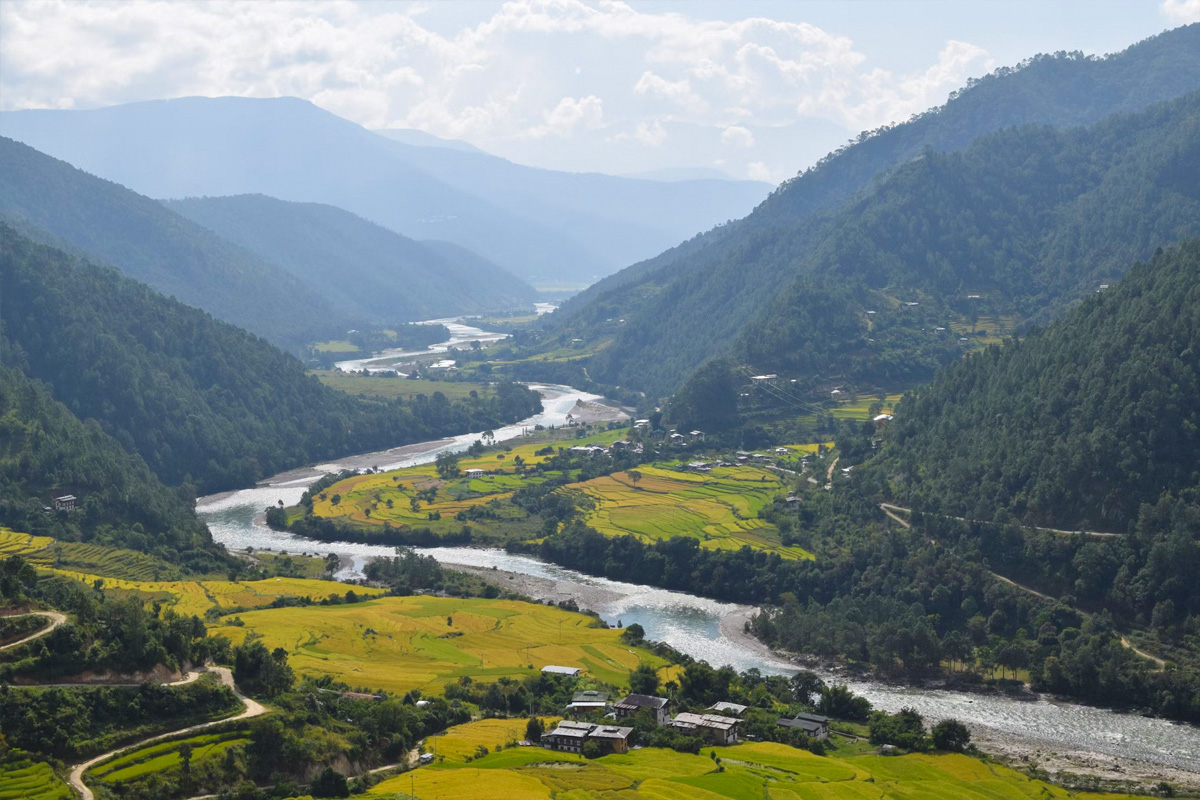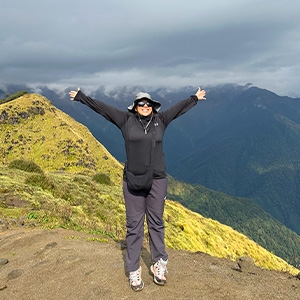Spring in Bhutan
Spring in Bhutan typically lasts from early March to mid-April before the onset of summer rains. The weather is mild, and both humidity and rainfall are low, making it an excellent time for outdoor activities. One of the highlights of spring in Bhutan is the clarity of the views, with stunning Himalayan panoramas visible at higher elevations.
Spring in Bhutan marks the end of the winter chill and the awakening of nature. During spring, Bhutan bursts into life with an explosion of colors as wildflowers blanket the hillsides and valleys. Rhododendrons, magnolias, and orchids paint the landscape in vibrant hues, creating a stunning backdrop for outdoor activities. The weather during spring is generally mild and pleasant, with daytime temperatures ranging from 10°C to 25°C (50°F to 77°F) and clear skies, making it an ideal time for exploration. This makes it an ideal time for trekking, hiking, and exploring Bhutan's scenic trails.

Moreover, the Spring Season in Bhutan also coincides with some of the most significant cultural festivals, like the Paro Tsechu, Thimphu Tshechu, and Rhododendron Festival where locals and tourists come together to celebrate with masked dances, religious rituals, and traditional music. These festivals offer visitors a chance to witness traditional masked dances, religious rituals, and cultural performances.
Summer in Bhutan
The long summer season in Bhutan begins in mid-April and extends to mid-September. Rainfall is heaviest from late June onwards, with frequent monsoons drenching parts of the country, particularly in the south. Flash floods are a risk during this time, impacting rural communities, road travel, and domestic flights. Despite the humidity, temperatures can drop substantially after nightfall, especially in the northern regions. July, the warmest month, sees temperatures reaching up to 31.5°C in the east and around 26°C in the capital, Thimphu.
Summer in Bhutan brings lush greenery and occasional monsoon rains, especially in the southern regions. Despite the rain, the countryside is teeming with life, making it a paradise for nature lovers. The temperatures during summer range from 15°C to 30°C (68°F to 86°F), with higher humidity levels. While trekking and outdoor activities may be limited due to the rain, summer is an excellent time for birdwatching as many migratory species flock to Bhutan during this season. Whitewater rafting on the country's rivers is another popular activity, offering thrilling experiences amidst the verdant landscapes.
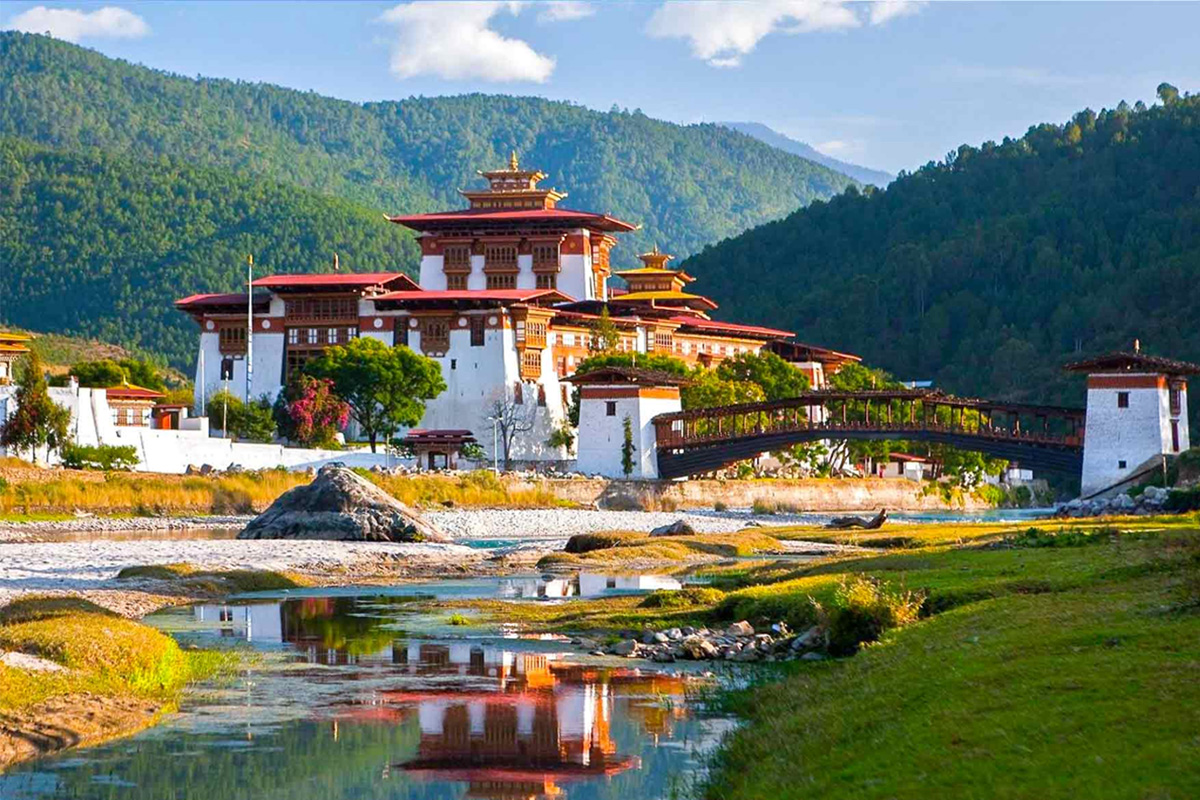
Autumn in Bhutan
Autumn in Bhutan typically begins in late September to early October, following the rainy season. This season is characterized by crisp, bright, and sunny days, making it another peak season for tourism. The views are often sensational during autumn, with higher elevations possibly experiencing early snowfall as the months progress.
Autumn is considered one of the Best Time to Visit Bhutan in 2024, thanks to its clear skies, cool temperatures, and stunning landscapes. The countryside comes alive with golden rice paddies, colorful forests, and clear mountain vistas. Daytime temperatures range from 10°C to 25°C (50°F to 77°F), making it perfect for outdoor adventures like trekking and sightseeing. Autumn also marks the peak festival season in Bhutan, with events like the Thimphu Tshechu attracting visitors from around the world. These festivals offer a unique opportunity to witness Bhutanese culture and traditions in all their glory, with elaborate masked dances, religious ceremonies, and cultural performances.

Winter in Bhutan
Winter in Bhutan brings colder temperatures, especially in the higher elevations, where snowfall is common. Days are cool, with temperatures ranging from 5°C to 15°C (41°F to 59°F), while nights can be chilly. Despite the chill, winter offers a different kind of beauty, with snow-capped mountains and clear, crisp air. It's a quieter time for tourism in Bhutan, making it perfect for travelers seeking solitude and introspection. Winter festivals like the Punakha Tshechu provide opportunities to experience Bhutanese culture and traditions in a more intimate setting, away from the crowds. Additionally, the clear skies offer excellent visibility for mountain views and photography enthusiasts.
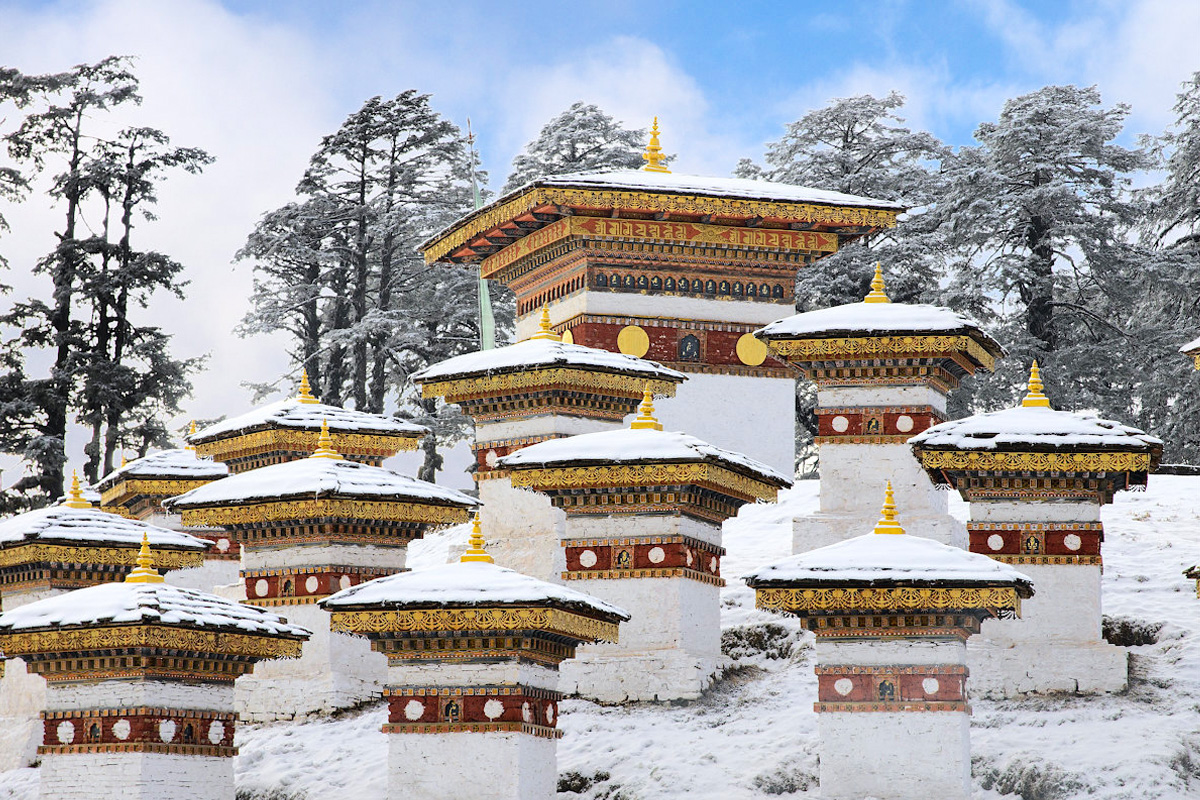
Winter in Bhutan spans from late November to early March. At elevations above 3,000 meters, heavy snowfall is common, creating a winter wonderland but also making travel challenging. Gale force winds roar through the highest mountain passes, earning Bhutan its nickname, the "Land of the Thunder Dragon." Remote villages and monasteries may become isolated, and road travel, particularly in the eastern regions, can be difficult. Despite these challenges, the central highlands and southern regions remain relatively warmer and are ideal for hiking. While sunny days are frequent, temperatures often dip below freezing, with January temperatures in Paro reaching around -6°C. However, conditions in the south and east are generally milder during this season.
A Month-by-Month Guide to Travel in Bhutan
Bhutan in January
January envelops Bhutan in a serene blanket of snow, marking one of the coldest months of the year. The country experiences occasional snowfall, particularly in higher elevations, creating a picturesque winter wonderland. Despite the chill, travelers can revel in the clarity of the views, as the crisp air offers unparalleled visibility of the majestic landscapes. With tourism at its nadir during this off-peak season, visitors can enjoy the tranquility of Bhutan's scenic beauty without the crowds. Accommodation prices dip during this time, presenting budget-friendly options for travelers. However, it's crucial to bundle up in warm clothes, especially when venturing into higher altitudes, where temperatures can plummet significantly.
Average Temperature: 10°C to -3°C
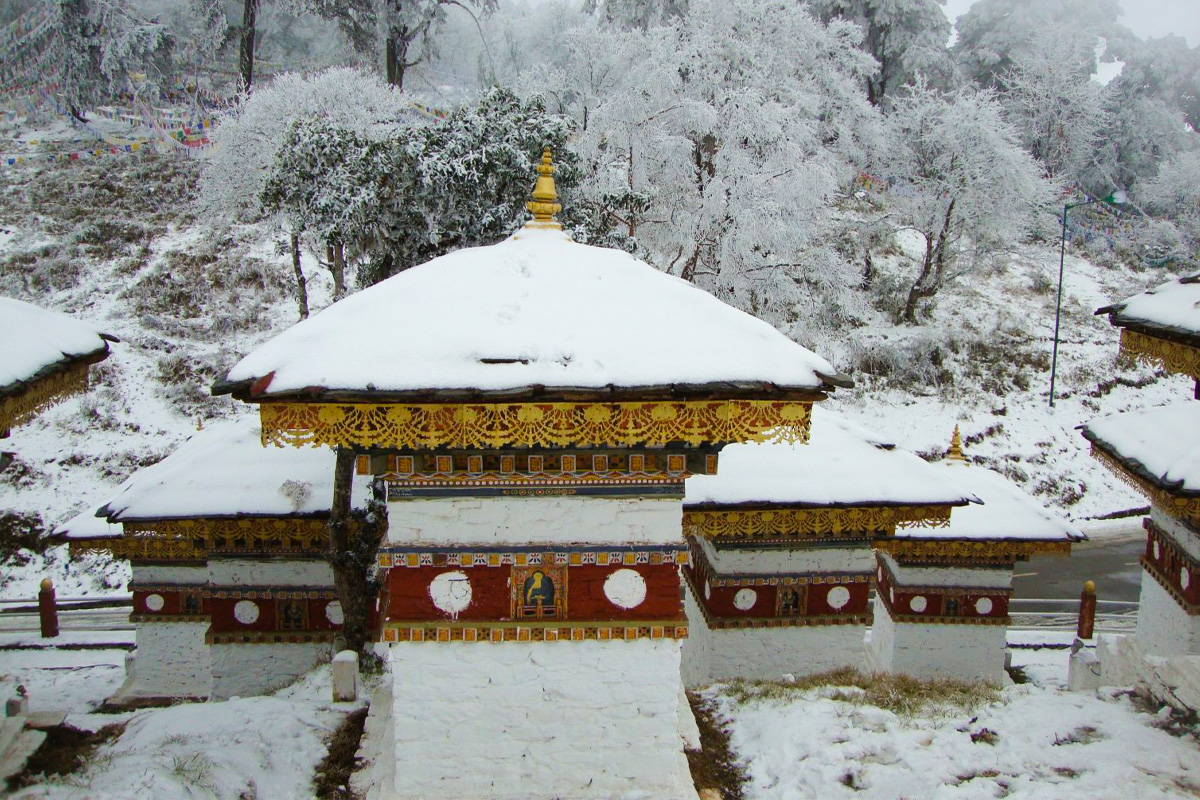
Bhutan in February
February witnesses the lingering embrace of winter in Bhutan, with remnants of snow adorning the landscapes. While some parts of the country may still experience snowfall in early February, clear skies prevail for the most part, offering unobstructed views of the surrounding vistas. However, the number of traditional dance festivals, known as Tsechus, maybe fewer during this month due to the prevailing weather conditions. Travelers can immerse themselves in the tranquil ambiance of Bhutan's winter landscapes, appreciating the serene beauty of the country at a leisurely pace.
Average Temperature: 10°C to -3°C
Events: Lhosar (Tibetan New Year)
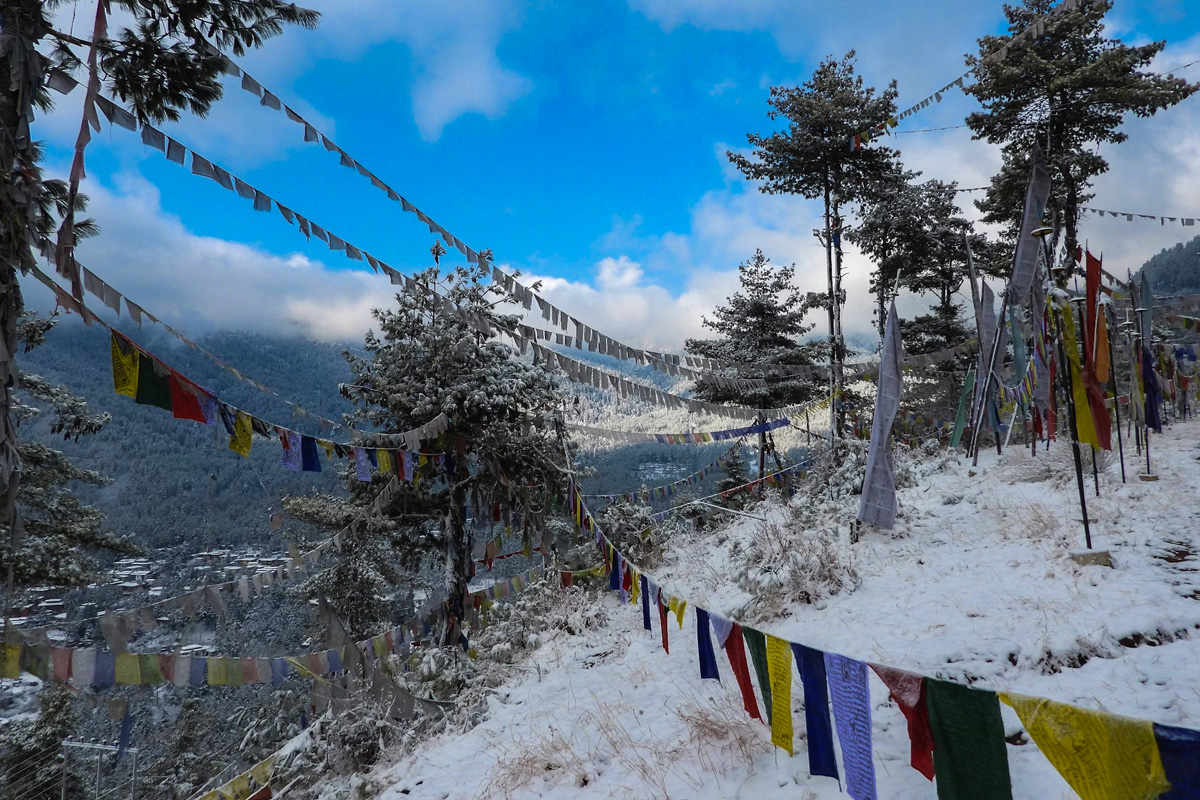
Bhutan in March
March heralds the onset of spring in Bhutan, marking the beginning of the peak tourist season. As temperatures gradually rise, the landscape awakens from its wintry slumber, adorned with vibrant blooms and lush greenery. Tourists flock to the Himalayan region to witness the breathtaking beauty of the changing seasons, as flowers come into full bloom and the snow-capped peaks provide a stunning backdrop. With improved weather conditions, outdoor enthusiasts embark on treks through Bhutan's pristine wilderness, immersing themselves in the natural splendor of the Himalayas.
Average Temperature: 3°C to 25°C
Events: Rhododendron Season, Peak Trekking Season

Bhutan in April
April emerges as an ideal month for trekking enthusiasts, offering mild temperatures and favorable weather conditions. As spring reaches its zenith, Bhutan's rugged terrain beckons adventurers to explore its hidden treasures amidst the backdrop of the majestic Himalayas. The enchanting Paro Tshechu, a traditional religious festival, adds to the festive atmosphere, attracting visitors from far and wide. However, as April marks the peak tourist season in Bhutan, travelers are advised to plan their trips to secure accommodations and permits.
Average Temperature: 3°C to 25°C
Events: Paro Tshechu Festival, Rhododendron Season, Trekking Season

Bhutan in May
Is May a good time to visit Bhutan? May ushers in the transition to warmer temperatures, as spring bids farewell to Bhutan's picturesque landscapes. While temperatures rise, the country experiences hot and humid weather conditions, particularly in lower altitudes. Despite the onset of summer, the remnants of spring linger in the form of blooming flowers and verdant forests, creating a captivating backdrop for travelers. With fewer tourists visiting Bhutan during this month, visitors can enjoy a more tranquil experience amidst the country's natural splendor.
Average Temperature: 3°C to 25°C
Events: Rhododendron season, Ura Yakchoe
Bhutan in June
June marks the advent of summer and the onset of the monsoon season in Bhutan. While daytime temperatures remain relatively mild, the country experiences occasional showers, particularly in the afternoons and evenings. Despite the rain, travelers can still explore Bhutan's cultural and natural attractions, as the showers typically occur at night, leaving the days relatively dry. However, trekking activities may be limited in certain regions due to the onset of the monsoon, making it advisable for travelers to check weather forecasts before embarking on outdoor adventures.
Average Temperature: 24°C to 25°C

Bhutan in July
July unfolds as Bhutan's wettest month, characterized by frequent and heavy rainfall across the country. The monsoon showers bring relief from the summer heat but also pose challenges for travelers, as road conditions may become treacherous and outdoor activities may be disrupted. Despite the inclement weather, travelers can still immerse themselves in Bhutan's rich cultural heritage, as the country's traditional festivals continue to take place amidst the rain. However, visitors should be prepared for limited visibility of the mountainous landscapes and the possibility of flight delays or cancellations due to adverse weather conditions.
Average Temperature: 24°C to 25°C
Events: Nimalung Tshechu, Kurjey Tshechu, Haa Summer Festival
Bhutan in August
August sees a continuation of the monsoon season in Bhutan, with intermittent rainfall and high humidity levels prevailing throughout the country. While the rains may disrupt outdoor activities, travelers can still enjoy cultural festivities and explore the country's vibrant heritage. Despite the inclement weather, August offers a unique opportunity to witness Bhutan's natural beauty in full bloom, as the rainfall nourishes the lush greenery and vibrant flora that adorn the landscape.
Average Temperature: 24°C to 25°C
Events: Ura Mushroom Festival

Bhutan in September
September marks the transition from the monsoon season to the fall season in Bhutan, bringing with it clearer skies and milder temperatures. As the rains subside, the landscape transforms, with the lush greenery of summer giving way to the warm hues of autumn. Travelers can enjoy panoramic views of the Himalayas and explore Bhutan's cultural attractions, as the country's traditional festivals resume amidst the crisp mountain air. The popular Thimphu Tsechu, a religious festival held in the capital city, takes center stage, offering visitors a glimpse into Bhutan's rich cultural heritage.
Average Temperature: 10°C to 23°C
Events: Thimphu Tsechu, Haa Tsechu, trekking/hiking season
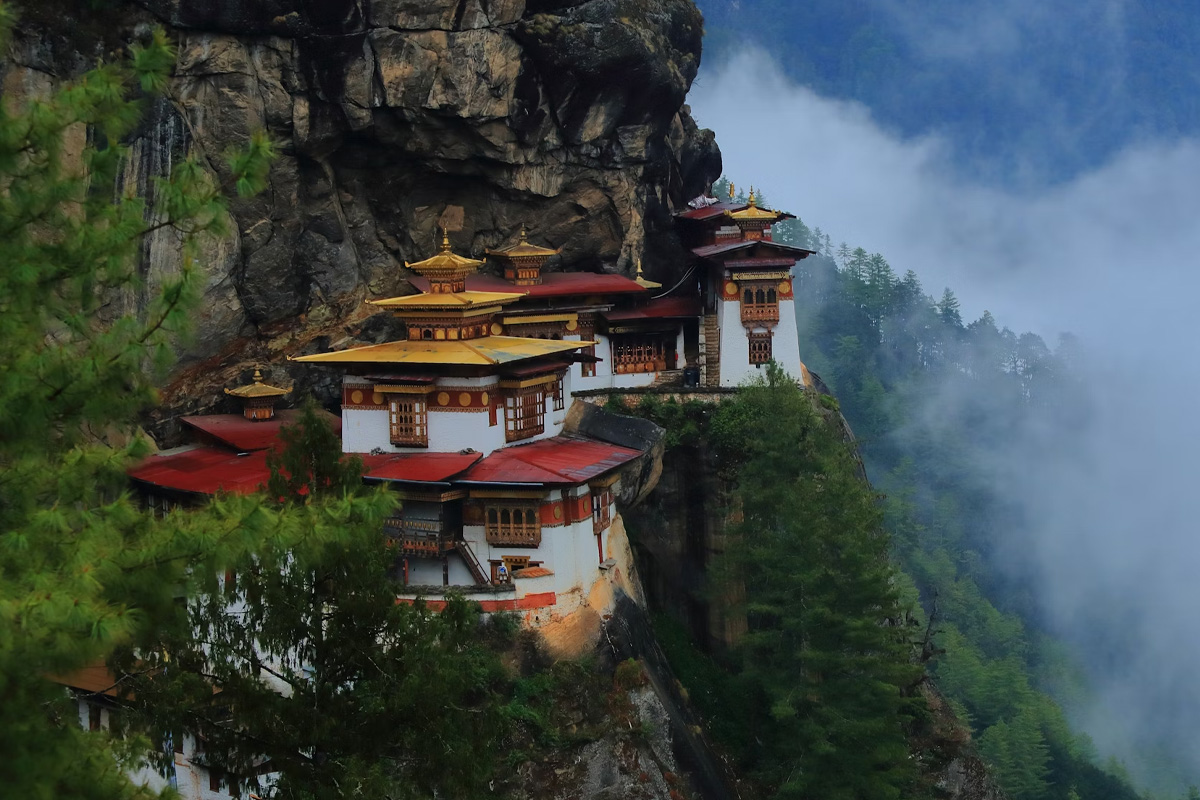
Bhutan in October
October emerges as one of the best months to visit Bhutan, offering mild temperatures and clear skies, making it ideal for outdoor activities and sightseeing. As autumn paints the landscape in warm hues, travelers can embark on scenic treks amidst the golden landscapes of the Himalayas. The month also sees a plethora of cultural festivals taking place across the country, providing visitors with an opportunity to immerse themselves in Bhutan's rich cultural heritage. However, as October marks the peak tourist season in Bhutan, travelers are advised to book accommodations and permits well in advance to avoid disappointment.
Average Temperature: 10°C to 23°C
Events: Thimphu Tsechu, Wangdue Tshechu, Gangtey Tsechhu, Royal Highlander Festival, Thangbi Mani Festival, Jomolhari Mountain Festival, trekking/hiking season
Bhutan in November
November indicates the onset of winter in Bhutan, with temperatures gradually dropping as the month progresses. Despite the chill in the air, travelers can still enjoy outdoor activities such as trekking and sightseeing, as the crisp mountain air and clear skies offer ideal conditions for exploration. The month also sees the celebrated Black-necked Crane Festival taking place in the Phobjikha Valley, providing visitors with a unique opportunity to witness the annual migration of these majestic birds. However, travelers should be prepared for colder temperatures, especially at higher altitudes, and dress accordingly to stay warm.
Average Temperature: 10°C to 23°C
Events: Black-necked Crane Festival, trekking/hiking season

Bhutan in December
December heralds the arrival of winter in Bhutan, with temperatures dropping significantly across the country. While trekking at higher altitudes may become challenging due to the cold weather, travelers can still explore Bhutan's lower regions and cultural attractions, as the country's vibrant heritage comes alive amidst the serene winter landscapes. With dwindling tourist numbers, December offers a quieter and more intimate travel experience, allowing visitors to immerse themselves in the tranquility of Bhutan's natural beauty.
Average Temperature: 10°C to -3°C
Events: Trashigang Tsechu, Mongar Tshechu
Each month in Bhutan offers a unique and captivating experience, allowing travelers to immerse themselves in the country's rich cultural heritage and breathtaking natural beauty. Whether you're seeking adventure in the mountains or tranquility amidst pristine landscapes, Bhutan promises an unforgettable journey year-round.
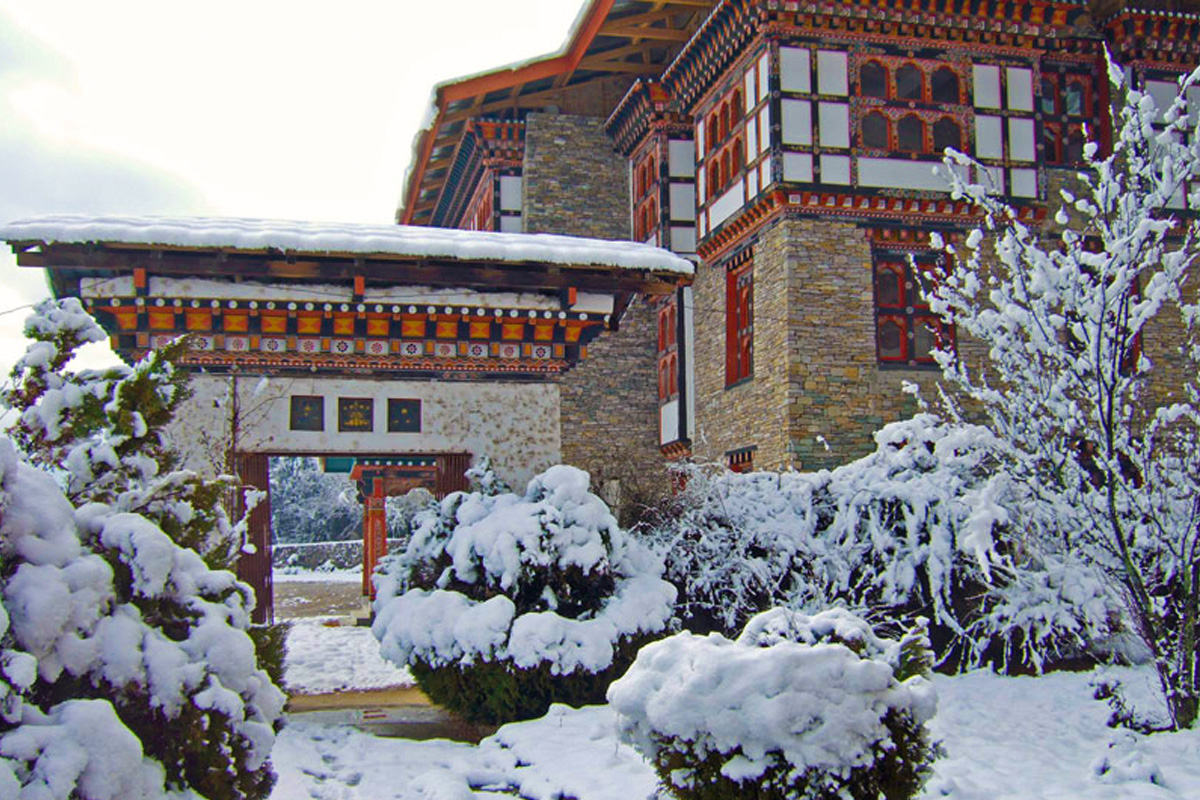
Peak Season in Bhutan (March to May, September to November)
Peak season refers to the time of the year when a destination experiences the highest influx of tourists. Here, in the case of Bhutan, the peak seasons are:
- March to May: This period encompasses spring in Bhutan, characterized by pleasant weather, blooming flowers, and clear views of the Himalayas. It's an ideal time for trekking and outdoor activities.
- September to November: Fall brings sunny weather, blue skies, and warm temperatures, making it another popular time to visit Bhutan. The landscape is adorned with vibrant autumn colors, and cultural festivals abound during this time.
Shoulder Season in Bhutan (December to February)
Shoulder season occurs between peak and off-seasons and is characterized by moderate tourism activity. Hence, Winter in Bhutan sees fewer tourists, making it the shoulder season. While temperatures drop, especially in higher altitudes, visitors can still enjoy clear skies and stunning mountain views. This period offers lower accommodation prices and fewer crowds, but trekking in high-altitude areas may be limited due to snow.
Off Season in Bhutan (June to August)
Off-season refers to the period when tourist activity is at its lowest level. This may coincide with less favorable weather conditions, such as heavy rainfall, extreme temperatures, or snowfall, depending on the destination. The monsoon season brings heavy rainfall and high humidity to Bhutan, making it the off-season for tourism. While the lush greenery adds to the scenic beauty, outdoor activities are often hindered by frequent rain showers. However, travelers can take advantage of lower prices on accommodations and experience a quieter side of Bhutan away from the crowds.
Understanding these seasonal variations can help travelers plan their trips to Bhutan based on their preferences for weather, crowds, and activities.

Conclusion
Exploring the beauty of Bhutan is a captivating experience that deserves careful consideration of timing. While Bhutan's charm is timeless, selecting the best time to visit ensures you witness its wonders at their peak. The ideal time depends on your preferences, whether it's witnessing vibrant festivals, embracing lush landscapes, or embarking on thrilling adventures.
Each season in Bhutan holds its allure, making it a year-round destination. However, considering factors such as weather, festivals, and personal interests can enhance your experience manifold. Whether you seek spiritual enlightenment, outdoor adventures, or experience the unique culture, Bhutan's timeless beauty awaits, promising a journey of a lifetime. Here is a guide on popular attractions in Bhutan for your reference. Also, you can contact us for easy tailor-made itineraries according to your preferences.

